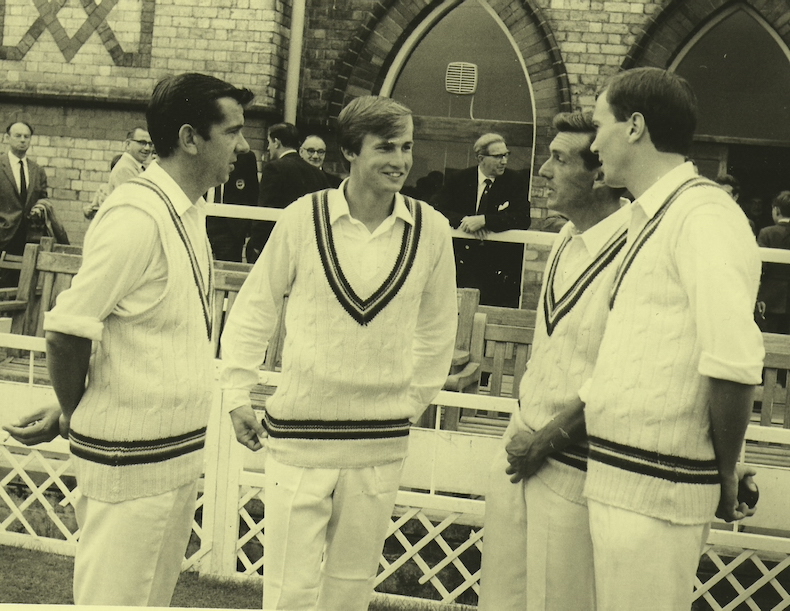A tribute to Long Ashton’s Greatest Cricketer
Willow (my dog) and I have taken our walk today to the cricket club situated along Yanley Lane. It is autumn now and the new season could not be further away. It is a peaceful setting and if you sit quietly for a while, you can feel the spirits of those who have played here over the long years, a fine body of men who have represented the village of Long Ashton at the noble game of cricket.
This summer, Long Ashton lost the finest cricketer that has ever represented the club. John Sullivan was among some great names, too: Chris Broad (father of recently retired England bowler Stuart) represented the club before playing 25 tests for England; and Shane Warne once toured with the club to Cornwall before representing Australia.
But none can come close to matching the career of John Patrick Sullivan who played out some of his finest days at Yanley Lane over many years.
If you look at the honours board in the pavilion, you will see his name as captain of the club from 1973 to 1979, then a year’s break before another long stint from 1981 to 1989, and then a final season as captain in 1991. That, in itself, is a very fine achievement. Yet, it does not begin to explain his legendary status in local cricket dating back to the early sixties.

As a keen cricketer, I would often be tasked with arranging fixtures against various teams both near and far. Over the years, the mention of Long Ashton would inevitably conjure up the name of John Sullivan in conversation with would-be opposition and a tale would no doubt unfold of how they had stood in awe as their team’s bowlers huffed and puffed in mounting despair as their best efforts were plundered to all corners of some rustic village cricket ground by John.
I encountered similar tales time after time when in conversation with other local cricketers.
I first met John long after he had retired from the game in the early 2000s. We would meet at the ground on a Saturday morning after he had completed his preparation of the wicket as his role as groundsman before the game that afternoon. In all our conversations about cricket, I had little idea of his status in the game, John being a most modest man.
Yet, some delving into the historical archives will reveal just some of his exploits with both bat and ball. In a pile of yellowing newspaper cuttings, headline after headline reels off some outstanding performances: June 1974 he bowled unchanged under a fiercely hot sun and snared eight Lodway wickets for just 39 runs; another report from August 1968 says ‘Sullivan Hits Quick 100’ displaying all the shots in the book in reaching his century in just 100 minutes at the crease; and the most remarkable was the ‘Sullivan Slams 198’.
After being put into bat by Chipping Sodbury, John dismantled the bowling in amassing 198 not out including nine sixes and 25 fours. The only reason he failed to score a double hundred was due to a misreading of signals from his teammates in the pavilion and he declared the innings closed.
A hundred in village cricket is a rare thing; a double hundred is virtually unheard of.
Breaking the mould
One thing to consider is that the game played then was often on very difficult wet wickets unlike today’s flat strips, and bowlers enjoyed all manner of advantages that today’s counterparts do not. The game, too, was played in a much more conservative fashion and run-scoring far more sedate than today.
But here is where John broke the mould… Not withstanding his solid defence, a requirement of any opening batsman in the game, his mindset was always to look to attack the bowlers. One can only imagine what opposition bowlers would be thinking when looking at the fixture list during his pomp.
Cricket is largely a game played in the mind and how John’s presence would have loomed large in that of the visiting bowlers. As that long-limbed, lean and lithe opening bowler of promise from some local shire runs in to bowl with a hard, shiny new ball. But somehow the ball now feels soft in the hand, less shiny; the seam less prominent. It’s lost all venom and by the time he reaches his delivery stride to release the ball, the bowler has already wilted.
The first delivery, a decent line, just nipping away a little off the seam, but a fraction overpitched. In a moment, Sullivan rocks onto his front foot and drills the ball back and beyond whence it came. It scorches across the turf, bouncing back off the boundary; no fielder has time to move. “No need to run for that stroke, John,” as there are murmurs of approval from team mates in the pavilion who have seen this all before. The bowler walks back to his mark, a little older, wiser perhaps and the only certainty in his mind is that it’s going to be a long, largely fruitless afternoon.
Greatest triumph
John Sullivan’s greatest triumph was to lead his side to the Bristol & District League Senior Division Trophy in the sun-drenched summer of 1976. His weight of runs that season along with able support from bowlers Cliff Moss and Jeff Bridle was the overwhelming reason behind their success. In 16 matches, he passed 50 no less than 10 times and had a top score of 114.
Out of the 2,329 runs scored by Long Ashton that season, John off his own bat scored over 40% of those runs at an average of almost 80. He only just fell short of an incredible 1,000 league runs. He also opened the bowling chipping in with the odd wicket and bowling miserly spells. To this day, this remains Long Ashton’s only Senior Division league win.

In recent years, I would seek out John in the Miners Rest enjoying a cider and would occasionally manage to tease out of him something from his cricketing past. He had a lengthy spell with Gloucestershire, making his first-class debut in 1968 and played just 23 matches for his county up until 1977. A modest return for such a talented player, perhaps he was missing the single-minded determination of his teammate Chris Broad, who resolutely refused to bat anywhere in the order but as opener; John was happy to bat wherever.
In my continued curiosity, I delved deeper into the available wealth of old scorecards found on the kind of website reserved for only the most serious students of the game. At one such game played at Bishops Cleeve on 20 August 1967, John turned out for Gloucestershire CC against the International Cavaliers. This was a prelude to the John Player League which started in 1969. These friendly matches played on a Sunday often to packed crowds were occasionally televised.
The Cavaliers were a team like the Harlem Globetrotters of cricket and featured some of the greatest players of the age. The Cavaliers that day featured such luminaries of the game as Clive Lloyd, Tom Graveney, Sadiq Mohammed, Lance Gibbs and Brian Statham.
John returned tidy figures of one wicket for seven having cleaned up West Indian great Lance Gibbs. Come his turn to bat he was bowled for a duck by a chap named Sobers – Sir Garfield Sobers, no less.
It took me a while before I could tease any titbits from John’s cricket career, such was his aversion to talking of his old exploits, and yet he had played with and against the finest players of his age. I liked him a lot and he loved his cricket. I am proud to say I knew him.
By David Milne

